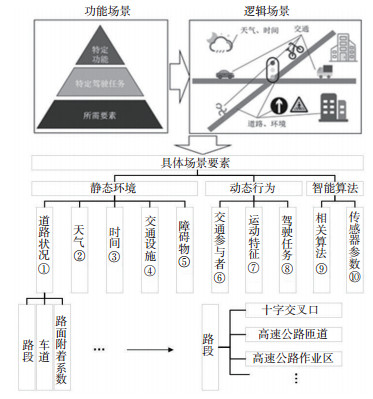A Method for Evaluating Safety of Driving Scenes with Intelligent Connected Vehicles Based on an Improved Cloud Combination Weighting
-
摘要: 准确可靠的驾驶场景安全性评价是智能网联车辆推广应用的基础,但智能网联驾驶场景复杂多变,以固定数值为指标权重的评价方法无法充分考虑因此带来的模糊性和随机性。为此,研究了基于改进云组合赋权的智能网联驾驶场景安全性评价方法。建立了包含静态环境层、动态行为层、智能要素层的智能网联驾驶场景要素库,制定场景设计方案;按照功能场景、逻辑场景、具体场景的顺序进行场景解构,提取相关要素,设计形成场景;引入云模型概念,结合博弈论思想改进云组合赋权;基于云模型运算法则构建综合云,表征各场景安全性,构建理想云评价模型;提出相对相似度指标作为评价结果,量化分析场景安全性并排序。依据场景设计方案进行仿真试验,对比层次分析法、优序图法、熵值法、变异系数法、博弈组合赋权及原云组合赋权等赋权评价方法,其评价结果与仿真结果在99%置信水平下显著相关,二者的皮尔逊相关系数为0.649,较上述其他评价方法分别提高了5.5%、7.8%、19.7%、13.7%、8.1%、0.8%;同时,该方法事故识别准确率为78.13%,高于Baumann等所用方法的44.29%和Xia等所用方法的57.2%。研究结果表明:基于改进云组合赋权的场景安全性综合评价方法能够兼顾主、客观赋权的优点,可以改善当前固定数值权重造成评价结果不够真实的缺陷,提高智能网联驾驶场景安全性评价的准确性。Abstract: Accurate and reliable safety evaluation of driving scenarios is the basis for promotion and application of intelligent connected vehicles. However, fuzziness and randomness brought by complex and changeable driving scenarios cannot be fully considered by evaluation methods based on fixed weighting. A safety evaluation method for driving scenarios of intelligent connected vehicles based on improved cloud combination weighting is proposed. The driving scenarios element database of intelligent connected vehicles is established, which includes static environment, dynamic behavior, intelligent element layers. A scenarios design scheme is developed. The scenarios are deconstructed into functional scenarios, logical scenarios, and specific scenarios. Each scenario is carefully designed with relevant elements. The concept of cloud model and the game theory are combined to improve cloud combination weighting. A comprehensive cloud is constructed based on the cloud model algorithm to characterize the security of each scenario, and an ideal cloud evaluation model is established. The relative similarity index is put forward as an evaluation result, enabling quantitative analysis and ranking of scenario safety. The reliability of this method is verified by comparing with the analytic hierarchy process (AHP), superiority chart, entropy method, variation coefficient method, game combination weighting, and normal cloud combination weighting. The Pearson correlation coefficient between evaluation and simulation results is 0.649, significantly correlated at the 99% confidence level. It is 5.5%, 7.8%, 19.7%, 13.7%, 8.1%, and 0.8% higher than the above evaluation methods, respectively. In the simulation test, the accuracy of accident identification of the proposed method is 78.13%, higher than the 44.29% used by Baumann et al, and 57.2% used by Xia et al. The result shows advantages of subjective and objective weighting evaluation methods. Inauthentic evaluation results caused by the current fixed numerical weight are improved, and the accuracy of relevant evaluation is increased.
-
表 1 智能网联驾驶场景要素库
Table 1. Driving scenarios element dataset of intelligent connected vehicles
层 要素 要素组成 静态环境层 道路状况 路段、车道、路面附着系数 天气 晴、阴、雨、雪、雾 时间 白天、黑夜、工作日、周末 交通设施 信号灯、交通标志标线、其他设施 障碍物 视野障碍、行车障碍 动态行为层 交通参与者 智能车、机动车、非机动车、行人、动物 车辆运动特征 速度、加速度、行驶方向 驾驶任务 跟驰、变道、超车 智能要素层 相关智能算法 各类智能驾驶算法 传感器参数 精度、探测范围、鲁棒性 表 2 待评价场景具体参数
Table 2. Specific parameters of the scenario to be evaluated expressway
指标项 具体水平设置 主车初速度v1/(km/h) 60、70、80、90、100、105、110、120 目标车辆初速度v2/(km/h) 30、40、50、60 减速带限速v1/(km/h) 50、60、70、120 路面附着系数f 0.6、0.65、0.7、0.75 V2X通信距离d/m 50、150 表 3 正交试验方案表
Table 3. Planning table for the orthogonal test
编号 v1/(km/h) v2/(km/h) vl/(km/h) f d/m 碰撞与否 碰撞及TTC最小时车速/(km/h) 1 60 30 50 0.6 50 否 31 2 60 40 60 0.65 150 否 3 3 60 50 70 0.7 50 是 17 4 60 60 120 0.75 150 是 21 5 70 30 60 0.7 50 是 17 6 70 40 70 0.75 150 是 14 7 70 50 120 0.6 50 是 18 8 70 60 50 0.65 150 否 0 9 80 30 70 0.6 50 是 37 10 80 40 120 0.65 150 否 2 11 80 50 50 0.7 50 是 16 12 80 60 60 0.75 150 是 31 13 90 30 120 0.7 50 是 45 14 90 40 50 0.75 150 是 28 15 90 50 60 0.6 50 是 18 16 90 60 70 0.65 150 是 20 17 100 30 50 0.6 50 是 43 18 100 40 60 0.65 150 是 22 19 100 50 70 0.7 50 是 23 20 100 60 120 0.75 150 是 24 21 105 30 60 0.7 50 是 42 22 105 40 70 0.75 150 是 21 23 105 50 120 0.6 50 是 40 24 105 60 50 0.65 150 是 10 25 110 30 70 0.6 50 是 53 26 110 40 120 0.65 150 是 23 27 110 50 50 0.7 50 是 24 28 110 60 60 0.75 150 是 22 29 120 30 120 0.7 50 是 60 30 120 40 50 0.75 150 是 22 31 120 50 60 0.6 50 是 28 32 120 60 70 0.65 150 是 18 表 4 各赋权方法所得权重
Table 4. Weight of each weighting method
方法/权重 目标车辆初速度 主车初速度 减速带限速 路面附着系数 V2X通信距离 AHP 0.245 0.195 0.182 0.204 0.174 优序图法 0.360 0.200 0.120 0.280 0.040 熵值法 0.108 0.165 0.257 0.165 0.305 变异系数法 0.145 0.179 0.258 0.178 0.240 表 5 各评价方法评价结果排序
Table 5. Ranking of evaluation results of each evaluation method
编号 AHP法 优序图法 熵值法 变异系数法 博弈组合赋权 云组合赋权 本文方法 1 21 18 23 22 21 21 22 2 7 9 9 10 7 14 14 3 11 4 16 16 13 9 12 4 3 1 10 7 3 7 5 5 17 12 21 19 18 19 19 6 4 3 6 5 5 8 7 7 25 20 29 28 25 26 26 8 2 5 3 2 2 3 3 9 26 26 27 27 27 27 27 10 20 19 18 20 20 22 20 11 14 8 15 15 14 10 13 12 1 2 1 1 1 2 1 13 29 25 30 30 29 29 29 14 6 6 4 4 6 4 4 15 22 23 22 21 22 20 21 16 8 11 8 9 9 6 8 17 28 28 26 26 28 28 28 18 16 21 13 14 16 17 16 19 19 15 19 18 19 18 18 20 10 10 14 13 12 12 10 21 23 24 24 24 23 23 23 22 12 13 11 11 11 13 11 23 30 30 31 31 31 30 30 24 9 14 5 6 8 5 6 25 31 31 28 29 30 31 31 26 24 27 20 23 24 25 24 27 18 17 17 17 17 16 17 28 5 7 2 3 4 1 2 29 32 32 32 32 32 32 32 30 13 16 7 8 10 11 9 31 27 29 25 25 26 24 25 32 15 22 12 12 15 15 15 表 6 相对相似度与碰撞速度相关性分析结果
Table 6. Correlation analysis results of relative similarity and collision velocity
参数名称 指标名称 相对相似度 碰撞速度 相对相似度 皮尔逊相关系数 1 0.649 Sig.(双尾) 0 个案数 32 32 碰撞速度 皮尔逊相关系数 0.649 1 Sig.(双尾) 0 个案数 32 32 表 7 相关研究简介及结果
Table 7. Brief introduction and results of relevant research
-
[1] ISO. Road Vehicles Safety of the Intended Functionality: ISO/PAS 21448: 2019[S]. Switzerland: ISO, 2018. [2] WANG M Z, WU X Y, TIAN H, et al. Efficiency and reliability analysis of self-adaptive two-stage fuzzy control system in complex traffic environment[J]. Journal of Advanced Transportation, 2022, 2022: 6007485. [3] 清华大学智能产业研究院, 百度Apollo. 面向自动驾驶的车路协同关键技术与展望[R]. 北京: 清华大学智能产业研究院, 2021.Intelligent industry research institute of Tsinghua University, Baidu Apollo. Key Technologies and prospects of Vehicle-road cooperation for autonomous Driving[R]. Beijing: Intelligent Industry Research Institute of Tsinghua University, 2021. (in Chinese) [4] KUSANO K D, GABLER H C. Comprehensive target populations for current active safety systems using national crash databases[J]. Traffic Injury Prevention, 2014, 15 (7): 753-761. doi: 10.1080/15389588.2013.871003 [5] HALLERBACH S, XIA Y, EBERLE U, et al. Simulation-based identification of critical scenarios for cooperative and automated vehicles[J]. SAE International Journal of Connected and Automated Vehicles, 2018, 1066 (1): 93-106. [6] XIAQ, DUAN J, GAO F, et al. Test scenario design for intelligent driving system ensuring coverage and effectiveness[J]. International Journal of Automotive Technology, 2018, 19: 751-758. doi: 10.1007/s12239-018-0072-6 [7] BAUMANN D, PFEFFER R, SAX E. Automatic generation of critical test cases for the development of highly automated driving functions[C]. 93rd Vehicular Technology Conference, Helsinki: IEEE, 2021. [8] 王庞伟, 于洪斌, 张为, 等. 城市车路协同系统下实时交通状态评价方法[J]. 中国公路学报, 2019, 32 (6): 176-187.WANG P W, YU H B, ZHANG W, et al. City car road collaborative system of real-time traffic state evaluation method[J]. China Journal of Highway and Transport, 2019, 32(6): 176-187. (in Chinese) [9] ZHANG P, ZHU B, ZHAO J, et al. Safety evaluation method in multi-logical scenarios for automated vehicles based on naturalistic driving trajectory[J]. Accident Analysis & Prevention, 2023, 180: 106926. [10] ZHANG Y, SUN B, ZHAI Y, et al. Machine learning based testing scenario space and its safety boundary evaluation for automated vehicles[C]. Journal of Physics: Conference Series, Wuhan: IOP Publishing, 2022 (1): 012017. [11] 王荣, 孙亚夫, 宋娟. 自动驾驶车辆道路测试场景评价方法与试验验证[J]. 汽车工程, 2021, 43 (4): 620-628.WANG R, SUN Y F, SONG J. Evaluation method and experimental verification of road test scenarios for autonomous vehicles[J]. Automotive Engineering, 2021, 43(4): 620-628. (in Chinese) [12] 修海林. 有条件自动驾驶汽车测试与综合评价研究[D]. 重庆: 重庆大学, 2019.XIU H L. Research on conditional autonomous vehicle testing and comprehensive evaluation[D]. Chongqing: Chongqing University, 2019. (in Chinese) [13] 翁建军, 刘管江. 基于组合赋权-云模型的水上机场场址评价方法[J]. 交通信息与安全, 2022, 40 (2): 126-134. doi: 10.3963/j.jssn.1674-4861.2022.02.015WENG J J, LIU G J. Asite evaluation of water aerodrome based on combined weighting and a cloud model[J]. Journal of Transport Information and Safety, 2022, 40 (2): 126-134. (in Chinese) doi: 10.3963/j.jssn.1674-4861.2022.02.015 [14] 马庆禄, 傅宝宇, 曾皓威. 智能网联环境下异质交通流基本图和稳定性分析[J]. 交通信息与安全, 2021, 39 (5): 76-84. doi: 10.3963/j.jssn.1674-4861.2021.05.010MA Q L, FU B Y, ZENG H W. Fundamental diagram and stability analysis of heterogeneous traffic flow in a connected and autonomous environment[J]. Journal of Transport Information and Safety, 2021, 39 (5): 76-84. (in Chinese) doi: 10.3963/j.jssn.1674-4861.2021.05.010 [15] 任秉韬, 邓伟文, 白雪松等. 面向智能驾驶测试的仿真场景构建技术综述[J]. 中国图象图形学报, 2021, 26 (1): 1-12.REN B T, DENG W W, BAI X S et al. Technologies of virtual scenario construction for intelligent driving testing[J]. Journal of Image and Graphics, 2021, 26 (1): 1-12. (in Chinese) [16] TANG I, BRECKON T P. Automatic road environment classification[J]. IEEE Transactions on Intelligent Transportation Systems, 2011, 12 (2): 476-484. doi: 10.1109/TITS.2010.2095499 [17] NAUMANN M, LAUER M, STILLER C. Generating comfortable, safe and comprehensible trajectories for automated vehicles in mixed traffic[C]. 22nd International Conference on Intelligent Transportation Systems, Maui: IEEE, 2018. [18] TLIG M, MACHIN M, KERNEIS R, et al. Autonomous driving system: model based safety analysis[C]. 48th Annual IEEE/IFIP International Conference on Dependable Systems and Networks Workshops, Luxembourg: IEEE, 2018. [19] ZHANG X, ZHAO Y, GAO L, et al. Evaluation framework and method of the intelligent behaviors of unmanned ground vehicles based on AHP scheme[J]. Applied Mechanics and Materials, 2015, 721: 476-480. [20] 李德毅, 杜鹢. 不确定性人工智能[M]. 北京: 国防工业出版社, 2014.LI D Y, DU Y. Uncertain artificial intelligence[M]. Beijing: National Defense Industry Press, 2014. (in Chinese) [21] ZHANG Z, LI Y, WANG X, et al. Assessment of river health based on a novel multidimensional similarity cloud model in the Lhasa River, Qinghai-Tibet Plateau[J]. Journal of Hydrology, 2021, 603: 127100. [22] 许昌林, 王国胤. 正态云概念的漂移性度量及分析[J]. 计算机科学, 2014, 41 (7): 9-14.XU C L, WANG G Y. Measurement and analysis of drift of normal cloud concept[J]. Computer Science, 2014, 41(7): 9-14. (in Chinese) [23] WEN X X, NIE Y, DU Z X, et al. Operational safety assessment of straddle-type monorail vehicle system based on cloud model and improved CRITIC method[J]. Engineering Failure Analysis, 2022, 139: 106463. [24] 中华人民共和国交通部. 公路路线设计规范: JTG D20— 2017[S]. 北京: 人民交通出版社, 2017.Ministry of Transport, People's Republic of China. Design specification for highway alignment: JTG D20—2017[S]. Beijing: China Communications Press, 2017. (in Chinese) [25] 郭延永, 刘攀, 吴瑶, 等. 基于冲突极值模型的非常规信号交叉口安全评价[J]. 中国公路学报, 2022, 35 (1): 85-92.GUOYY, LIUP, WU Y, et al. Safety evaluation of unconventional signalized intersection based on traffic conflict extreme model[J]. China Journal of Highway and Transport, 2022, 35 (1): 85-92. (in Chinese) -





 下载:
下载:




